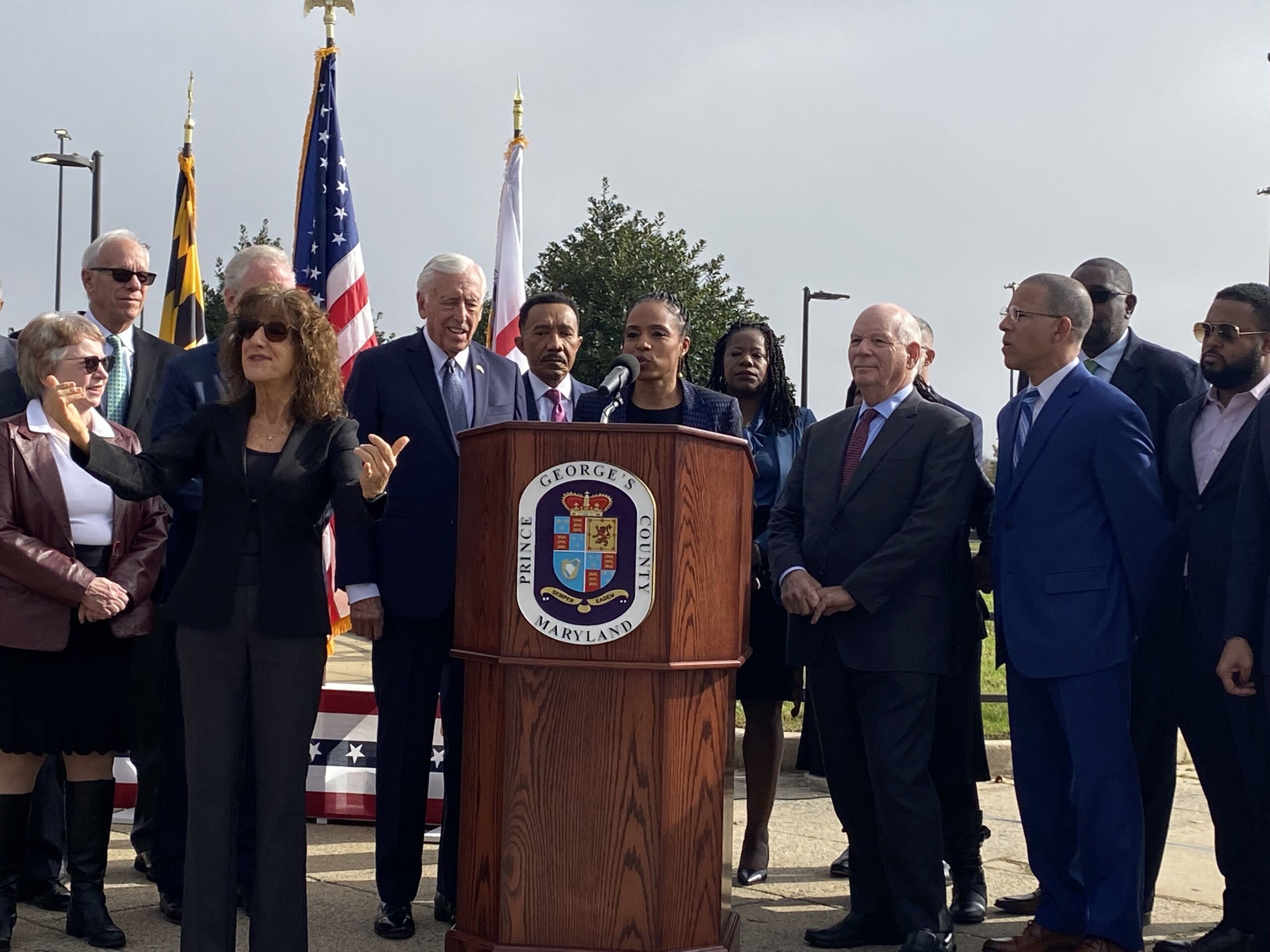A long list of Maryland leaders at the federal, state, and local level, many of them Black, stood in front of the entrance to the Greenbelt Metro Station Friday and spoke into microphones as if there was a speaker connected to the Oval Office.
While the audience on hand may have been local media, the intended audience was the Biden administration.
Maryland’s elected leaders at all levels were blindsided by the updated scoring system put out by the General Services Administration as it gets ready to choose the site of a new FBI headquarters. Several of them took turns blasting those changes, while also focusing on the president’s pledge to make the federal government more equitable, which was issued through an executive order on Day One.
“The General Services Administration has said it would focus on access to transit, cost, and environment impact when selecting a new site,” said county executive Angela Alsobrooks. “Make no mistake, by any objective measure both of the sites in Prince George’s County are superior based on these GSA criteria.”
She also pointed out the sites in Landover and Greenbelt were both much closer to being ready for new construction compared to the site in Springfield, Virginia. But then she homed in on the main point everyone was delivering to the White House.
“Our sites in Prince George’s County help advance President Biden’s Executive Order on advancing racial equity and support for underserved communities through the federal government,” she said.

“A new consolidated FBI headquarters in Prince George’s County represents one of these essential transformative actions,” said Maryland Democratic congressman and House Majority Leader Steny Hoyer. He also argued that while the county is home to nearly half of the federal government’s warehouses, it’s woefully underrepresented in the amount of actual federal offices.
“We are more than a warehouse county,” said Hoyer to lots of applause from the other leaders. “The facility would bring quality public-sector jobs to Black communities and an influx of customers to local, Black-owned small businesses.”
While equity is the argument being made to the White House, there’s also frustration that the scoring system for comparing sites changed so drastically, with a lot of focus and even mockery made about the new top priority being proximity to the FBI’s training academy in Quantico, a place that headquarters level leaders almost never have to travel to.
“If … the goal posts on a football field are 100 yards apart and yet when you get the ball, all of a sudden, they’re 150 yards apart, somebody is playing a game by changing the rules of the game,” said Baltimore-area congressman Kweisi Mfume.
“Bait and switch, sandbag, whatever term you want to use, that is what has happened,” bellowed Prince George’s County Councilman Mel Franklin.
“Adding that Quantico piece, clearly there’s somebody who wanted to weight this and change the goal posts,” said Sen. Chris Van Hollen, “in order to try to push things in that direction.”
As other leaders shouted out “Shame!” when she mentioned the new weight being put on Quantico, Alsobrooks called it “an abrupt change that clearly favors Springfield and puts our county at a disadvantage.”
“Why is the GSA suddenly changing the rules of the game in the 11th hour? Decisions like this one have major generational consequences,” she said.
Glenn Ivey, a former assistant U.S. Attorney and the heavy favorite to be voted into the House of Representatives next week in a district that would represent the Greenbelt site, said he knows from experience the Quantico factor wasn’t made in good faith.
“They barely ever go down there. The agents who do the day-to-day work maybe go once or twice a year, if that,” said Ivey.
Noting the Greenbelt site’s proximity to both the U.S. Attorney’s office near the federal courthouse in Greenbelt, as well as FBI field offices in D.C. and Baltimore, he compared it to the military locating the Pentagon near the United States Military Academy in West Point, New York.
“It doesn’t make any sense because there’s a bigger mission that needs to be accomplished elsewhere,” he said.
Van Hollen, who sits on a Senate Appropriations Subcommittee that’s been involved with funding the new headquarters, also had an observation to the GSA.
“You would think that cost to the taxpayer would be more heavily weighted than it is in this plan,” said Van Hollen. “I can tell you that the GSA comes before our committee and they say ‘We have a lot of big needs and we don’t have enough money.’ So why wouldn’t you weigh cost as a higher factor as part of the decision making than what the criteria put forward have been.”
At this point, cost is the smallest consideration of anything in the selection process, though it’s believed that the cost of transforming sites at Greenbelt and Landover would be far cheaper than reconfiguring warehouse space used by the GSA at the Springfield site.
But above all else, the main argument put forth today was about equity and using the federal government to build up prosperous communities, businesses, and contractors the way the Pentagon impacted northern Virginia and NIH impacted Montgomery County and the Interstate 270 biotech corridor.
“When it comes to meeting that objective and the economic opportunity and development that it brings to small businesses, to medium-sized businesses, to large businesses, this is a big, big deal when it comes to meeting the goals of equity,” said Van Hollen.
He said that when GSA and FBI give “that criteria lower weight, they’re clearly not listening to what the president of the United States had to say when he was worn in and laid out his agenda.”
While there’s widespread suspicion that the GSA and FBI have made up their minds to pick Springfield, with the GSA taking the preference of FBI leaders into account, it’s not clear when that decision would be announced. It is, however, expected to come within the next few months.
The White House has been pretty hands off through the process so far. Maryland leaders are hoping this public call out and lobbying effort will change that.








